Redbuds in bloom are a most welcome harbinger of spring. Their dense clusters of magenta flowers bloom early, providing splashes of color against a winter landscape of browns and grays. Is the name redbud really the best our ancestors could come up with for this beautiful tree? How could they call that color “red”? Even Wikipedia manages a more accurate “pink to purple.” Other sources are more specific, identifying the brilliant flora as bright pink, rosy pink, magenta, or reddish purple.
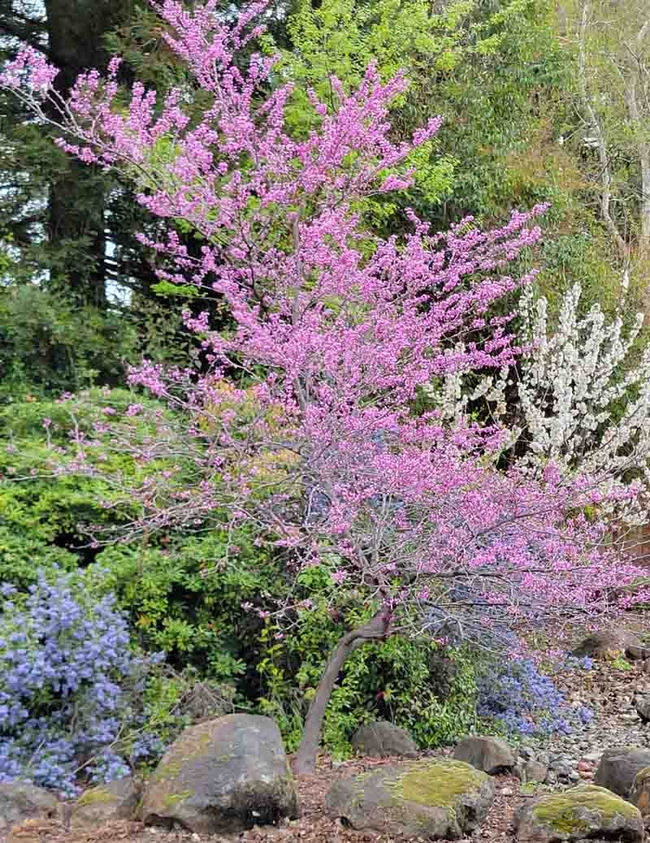
Cercis occidentalis is native to the arid western states. It is commonly known asWestern or California redbud, and sometimes Arizona redbud. Occidentem is Latin for “western sky” or “part of the sky in which the sun sets,” derived from the Latin verb occido – “go down, set.” The Occident is the longitudinal opposite of the Orient, and many species from China and other eastern regions are termed orientalis. Somewhere along the line, C. occidentalis acquired the second or synonymous binomial C. orbiculatum. Orbiculate translates naturally enough as round or circular in shape (in this case, in reference to the redbud's leaves). And if you are thinking now of Judas Tree as a common name, that belongs to the Eastern redbud. (Interestingly, the Latin name of the Eastern redbud is C. canadensis. And yes, you guessed it: canadensis is used in taxonomy to denote species indigenous to or strongly associated with Canada).
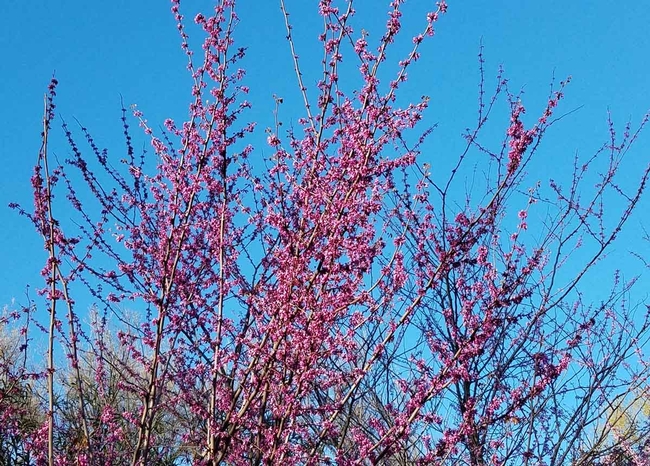
A hardy plant, the redbud is drought tolerant, sun-loving, and successful in a variety of soils. Typically, it prefers rather harsh environments with marginal, well-drained soils. It grows best in chaparral ecosystems below 4,000 feet in elevation, and prefers canyon walls and other steep slopes. It can also be found in gravely and rocky soils along streams above their flood zone. Western redbud tolerates some seasonal water and will grow in the bottom of ephemeral streambeds in little pockets, as well as on foothill benches, or tucked into crannies created by boulder outcroppings.
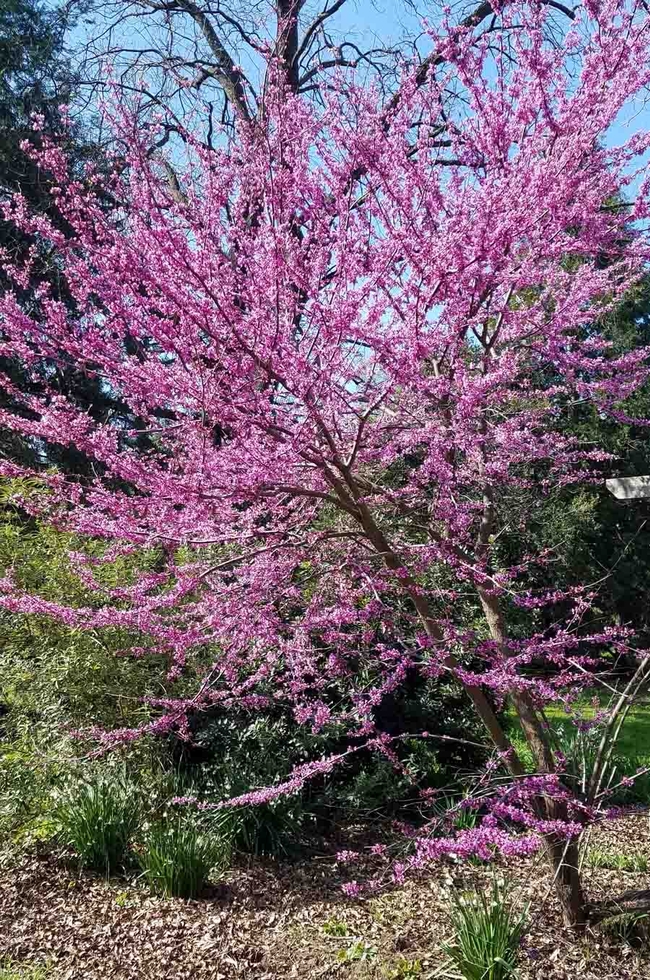
Western redbud is a popular landscape tree on the valley floor precisely because of its impressive beauty, which isn't restricted to eye-catching floral displays. The rounded, heart-shaped leaves are a silky combination of copper and green when they first emerge, darkening to various shades of green, gray-green, or blue-green. According to the USDA, the Western redbud's “autumn display of yellow turning to red and brown rival that of some eastern hardwoods.” This plant sets its fruit in the form of thin dry seed pods in autumn. Each pod contains about seven hard, bean-like seeds. As they ripen, the pods change in color from purple to russet brown. (On some redbuds, the mature pods hang on the branches into the next winter.) Once the redbud has shed itself of leaves and pods, the bare branches provide winter beauty as a silver-gray silhouette.
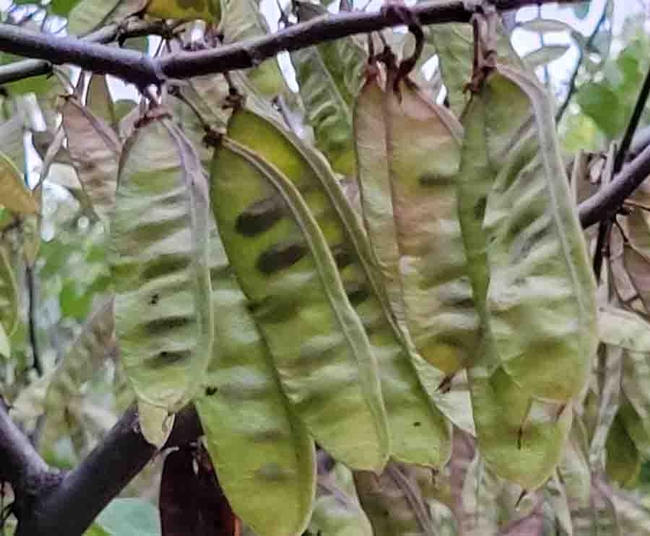
As a legume, redbud is an edible native. Native Americans enjoyed redbud flowers, young seed pods, and even young leaves, both raw and cooked. Apparently, redbud flowers taste almost as good as they look. Fully-opened flowers are somewhat tart and slightly sweet, and add interesting color and flavor (and Vitamin C!) to salads.
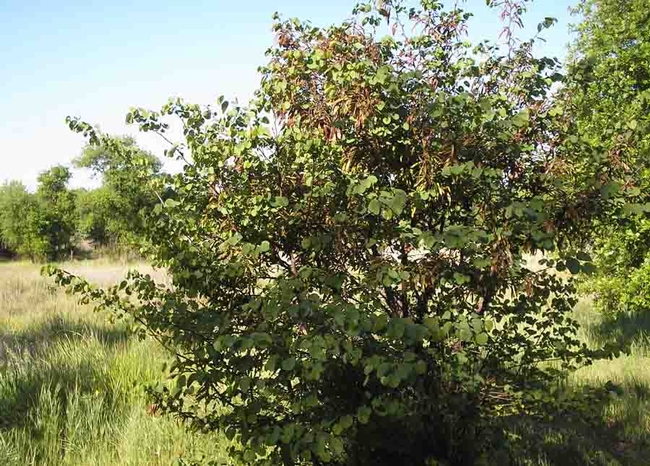
This beautiful and hardy native shrub is nowhere near as dull and plodding as its common name implies. While the redbud makes year-round contributions to the landscape, the Arbor Day Foundation correctly notes that “the sheer springtime beauty of the redbud may be its greatest hold on the American spirit.”
UC Master Gardeners of Butte County are part of the University of California Cooperative Extension (UCCE) system. To learn more about us and our upcoming events, and for help with gardening in our area visit our website. If you have a gardening question or problem, email the Hotline at mgbutte@ucanr.edu or leave a phone message on our Hotline at 530-552-5812. To speak to a Master Gardener about a gardening issue, or to drop by the MG office during Hotline hours, see the most current information on our Ask Us section of our website.
Note: This is the second in a three-part series on native plants that have proven successful on the author's property along the Lindo Channel in Chico. The previous article discussed large trees; the final article in the series will cover smaller shrubs.
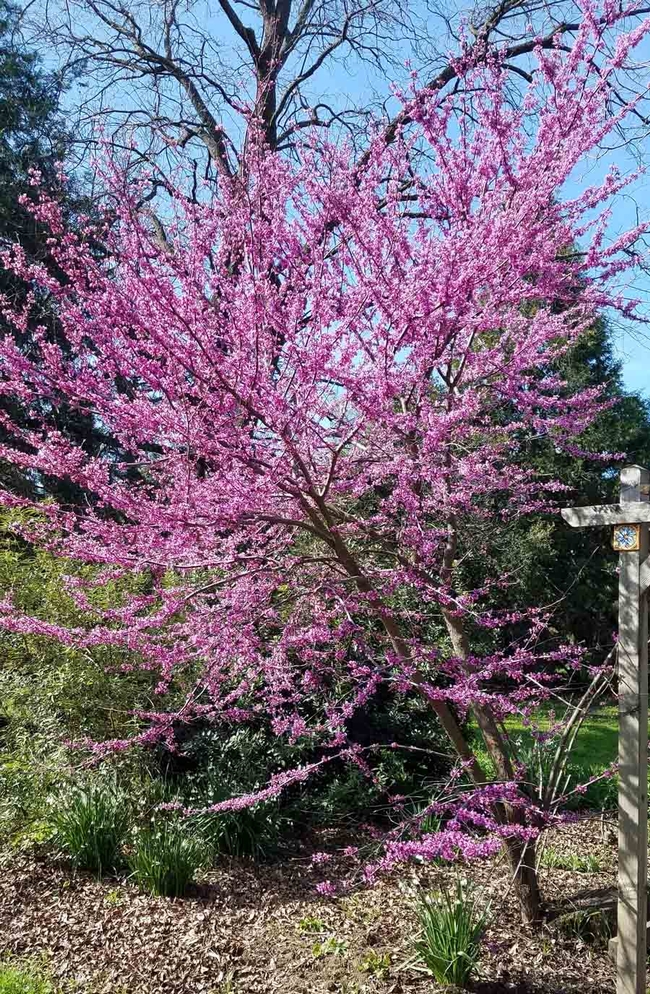
Western redbud (Cercis occidentalis) is native on dry slopes of the coast ranges and Sierra Nevada foothills to 4500 feet and eastward to Utah (usually situated next to a spring or seasonal creek). It is a deciduous, multi-trunked shrub or small tree with a long life span, growing two to three feet per year and reaching six to twenty feet over time. Magenta flowers appear in February to April before the leaves, and last for two to three weeks. The leaves are kidney-shaped and bluish-green; they can provide a lovely garden backdrop for summer-blooming plants, and turn yellow in fall. Reddish-purple seed pods hang from the branches in winter. The bushes are impressive in groups.
Western redbud likes full sun, and will grow faster if given some summer water. It will tolerate clay soils and soils with lime or acid (pH levels 5.5 to 8). It can provide good stabilization along a ridge or bank. The roots perform the useful role of fixing nitrogen. A good winter chill is necessary for good flower set. The flowers and young pods are edible; the plants will self-seed.
Western redbud attracts hummingbirds, goldfinches, butterflies, and bees (including leaf-cutter bees) to its flowers. It is deer resistant, and resistant to oak root fungus. While generally pest-free, Western redbud is susceptible to caterpillars and scales, and to crown and root rot.
California buckeye (Aesculus californica) is found in a variety of environments, including coastal sage scrub, mixed-evergreen forest, riparian (alongside rivers & creeks) and central oak woodland communities. It is a long-lived deciduous small tree, normally growing to 15 feet (occasionally up to 39 feet), with multiple trunks. Showy white six-inch scented flower spikes appear in April to May, after leafing.
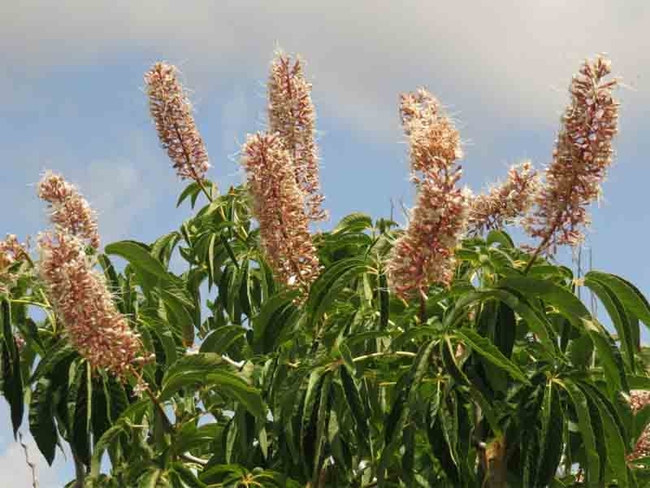
The nectar of the California buckeye attracts hummingbirds, native bees and butterflies.
California buckeye is poisonous to livestock, Asian honeybees, and fish. Its seeds are toxic unless processed. It is deer resistant.
Toyon (Heteromeles arbutifolia). Also known as Christmas berry, Toyon is native to much of California. It is a multi-stemmed evergreen shrub to small tree with white flowers in summer and red berries in winter. Toyon can grow quickly to six to eight feet high (sometimes reaching as high as 20 feet) and four to five feet wide. Toyon makes a good screen or specimen plant.
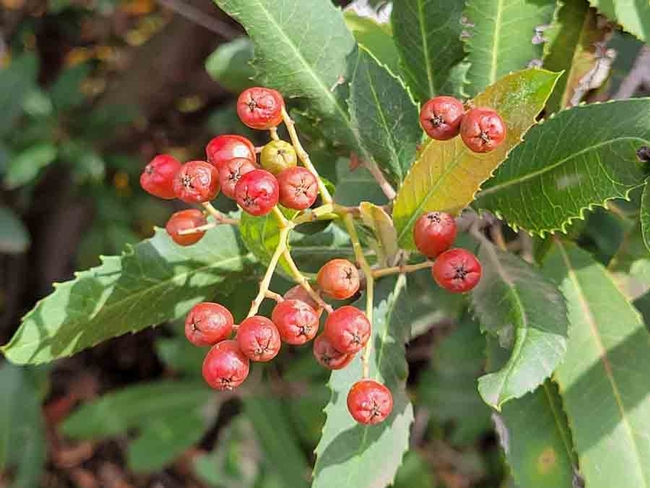
Toyon attracts a wide range of pollinator insects including native bees, pollinator flies, and butterflies. Winter fruit attracts cedar waxwings, towhees, finches, flickers, grosbeaks, bluebirds, robins, thrushes, mockingbirds, quail, tanagers, warblers and sparrows. Often the ripe berries ferment before they are eaten, so birds may get a little tipsy. Mammals, including coyotes and bears, also eat and disperse the berries.
Toyon is susceptible to fire blight and root rot if over-watered. Over time, it will become deer resistant.
California flannelbush (Fremontodendron californicum) is native to a number of California plant communities. This evergreen shrub grows quickly to five feet (and can eventually reach up to 20 feet). Showy yellow flowers, three inches across, appear in spring.
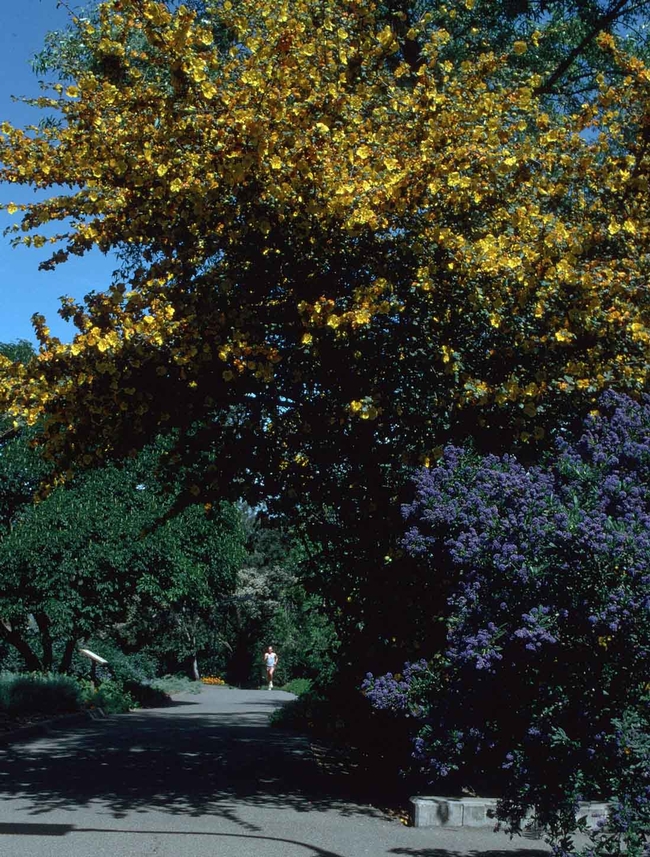
California flannelbush attracts bees and butterflies, has few pest problems, and is deer resistant.
UC Master Gardeners of Butte County are part of the University of California Cooperative Extension (UCCE) system. To learn more about us and our upcoming events, and for help with gardening in our area, visit our website. If you have a gardening question or problem, email the Hotline at mgbutte@ucanr.edu or leave a phone message on our Hotline at (530) 538-7201. To speak to a Master Gardener about a gardening issue, or to drop by the MG office during Hotline hours, see the most current information on our Ask Us Hotline webpage.
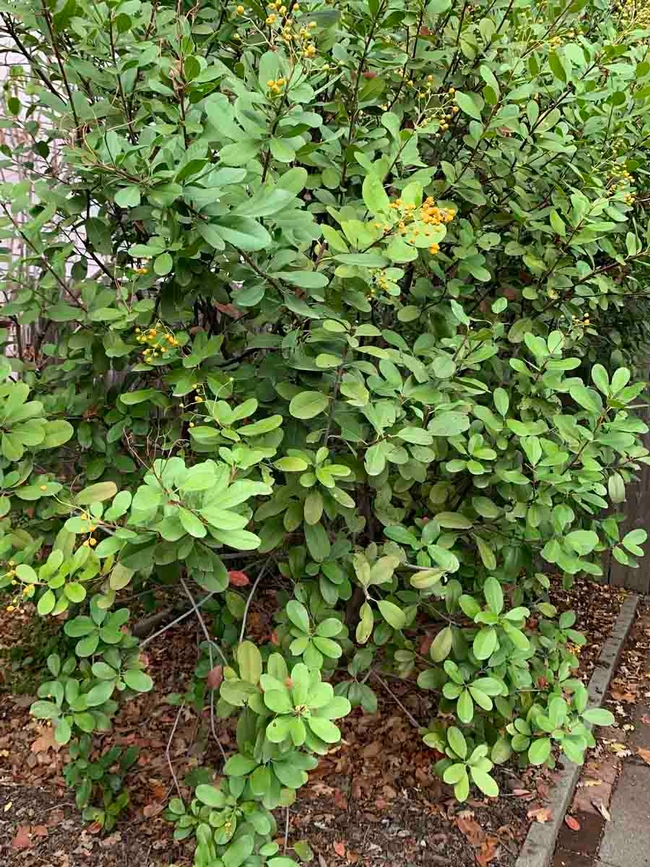
- Author: Laura Lukes
Redbuds in bloom are a most welcome harbinger of spring. Their dense clusters of magenta flowers bloom early, providing splashes of color against a winter landscape of browns and grays. Is the name redbud really the best our ancestors could come up with for this beautiful tree? How could they call that color “red”? Even Wikipedia manages a more accurate “pink to purple.” Other sources are more specific, identifying the brilliant flora as bright pink, rosy pink, magenta, or reddish purple.
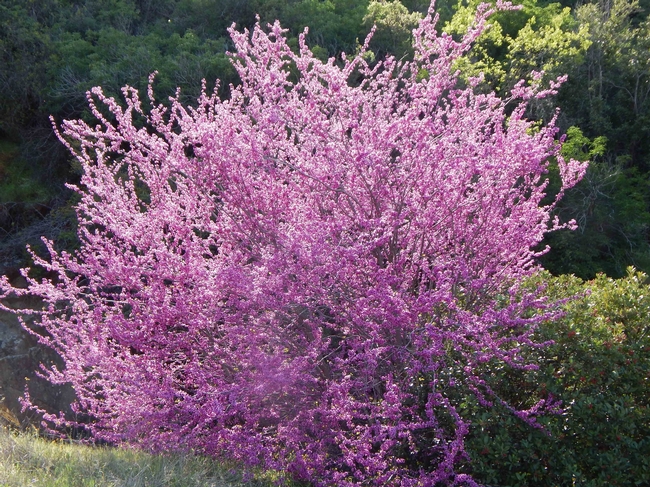
Cercis occidentalis is native to the arid western states. It is commonly known as Western or California redbud, and sometimes Arizona redbud. Occidentem is Latin for “western sky” or “part of the sky in which the sun sets,” derived from the Latin verb occido – “go down, set.” The Occident is the longitudinal opposite of the Orient, and many species from China and other eastern regions are termed orientalis. Somewhere along the line, C. occidentalis acquired the second or synonymous binomial C. orbiculatum. Orbiculate translates naturally enough as round or circular in shape (in this case, in reference to the redbud's leaves). And if you are thinking now of Judas Tree as a common name, that belongs to the Eastern redbud. (Interestingly, the Latin name of the Eastern redbud is C. canadensis. And yes, you guessed it: canadensis is used in taxonomy to denote species indigenous to or strongly associated with Canada).
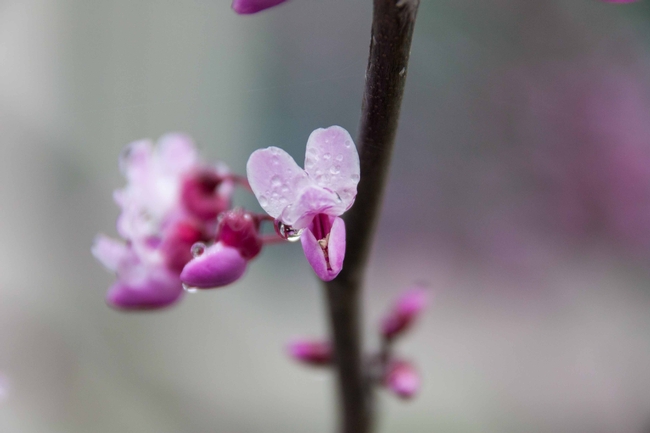
A hardy plant, the redbud is drought tolerant, sun-loving, and successful in a variety of soils. Typically, it prefers rather harsh environments with marginal, well-drained soils. It grows best in chaparral ecosystems below 4,000 feet in elevation, and prefers canyon walls and other steep slopes. It can also be found in gravely and rocky soils along streams above their flood zone. Western redbud tolerates some seasonal water and will grow in the bottom of ephemeral streambeds in little pockets, as well as on foothill benches, or tucked into crannies created by boulder outcroppings.
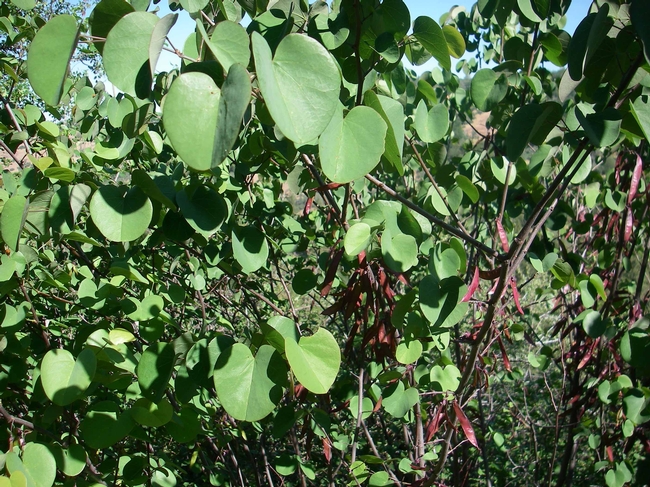
Western redbud is a popular landscape tree on the valley floor precisely because of its impressive beauty, which isn't restricted to eye-catching floral displays. The rounded, heart-shaped leaves are a silky combination of copper and green when they first emerge, darkening to various shades of green, gray-green, or blue-green. According to the USDA, the Western redbud's “autumn display of yellow turning to red and brown rival that of some eastern hardwoods.” This plant sets its fruit in the form of thin dry seed pods in autumn. Each pod contains about seven hard, bean-like seeds. As they ripen, the pods change in color from purple to russet brown. (On some redbuds, the mature pods hang on the branches into the next winter.) Once the redbud has shed itself of leaves and pods, the bare branches provide winter beauty as a silver-gray silhouette.
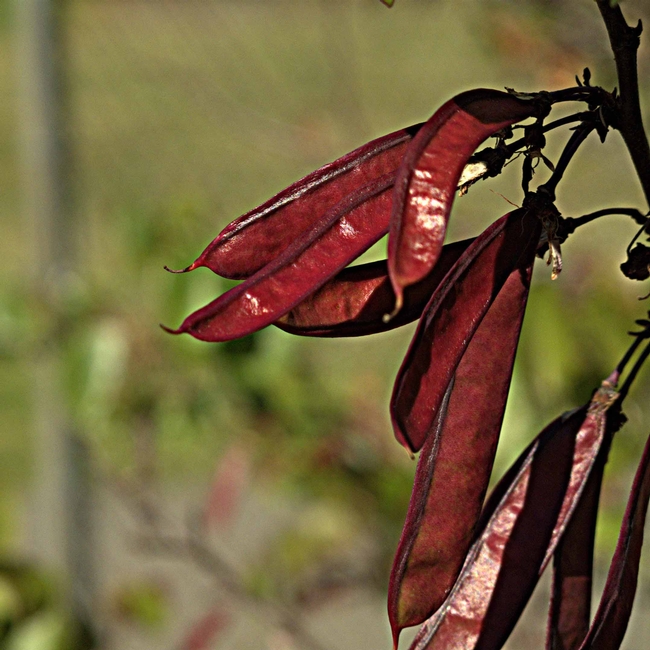
As a legume, redbud is an edible native. Native Americans enjoyed redbud flowers, young seed pods, and even young leaves, both raw and cooked. Apparently, redbud flowers taste almost as good as they look. Fully-opened flowers are somewhat tart and slightly sweet, and add interesting color and flavor (and Vitamin C!) to salads.
This beautiful and hardy native shrub is nowhere near as dull and plodding as its common name implies. While the redbud makes year-round contributions to the landscape, the Arbor Day Foundation correctly notes that “the sheer springtime beauty of the redbud may be its greatest hold on the American spirit.”
For more information on gardening in our area, visit the Butte County Master Gardener webpage at: http://ucanr.edu/sites/bcmg/. If you have a gardening question or problem, call our Hotline at (530) 538-7201 or email mgbutte@ucanr.edu.
Photo Credits:
Cercis occidentalis blossom close-up by Allicon Garcia: https://ucanr.edu/repository/view.cfm?article=166638%20&search=Cercis
Cercis occidentalis near Briceberg by LaurentianShield - Own work, CC BY-SA 4.0, https://commons.wikimedia.org/w/index.php?curid=78098719
Cercis occidentalis leaves and seed pods by John Comeau - Own work, CC BY-SA 3.0, https://commons.wikimedia.org/w/index.php?curid=26493957
Cercis occidentalis seed pod close-up by John Rusk from Berkeley, CA, United States of America - H20150416-0002—Cercis occidentalis—RPBG, CC BY 2.0, https://commons.wikimedia.org/w/index.php?curid=59290592


